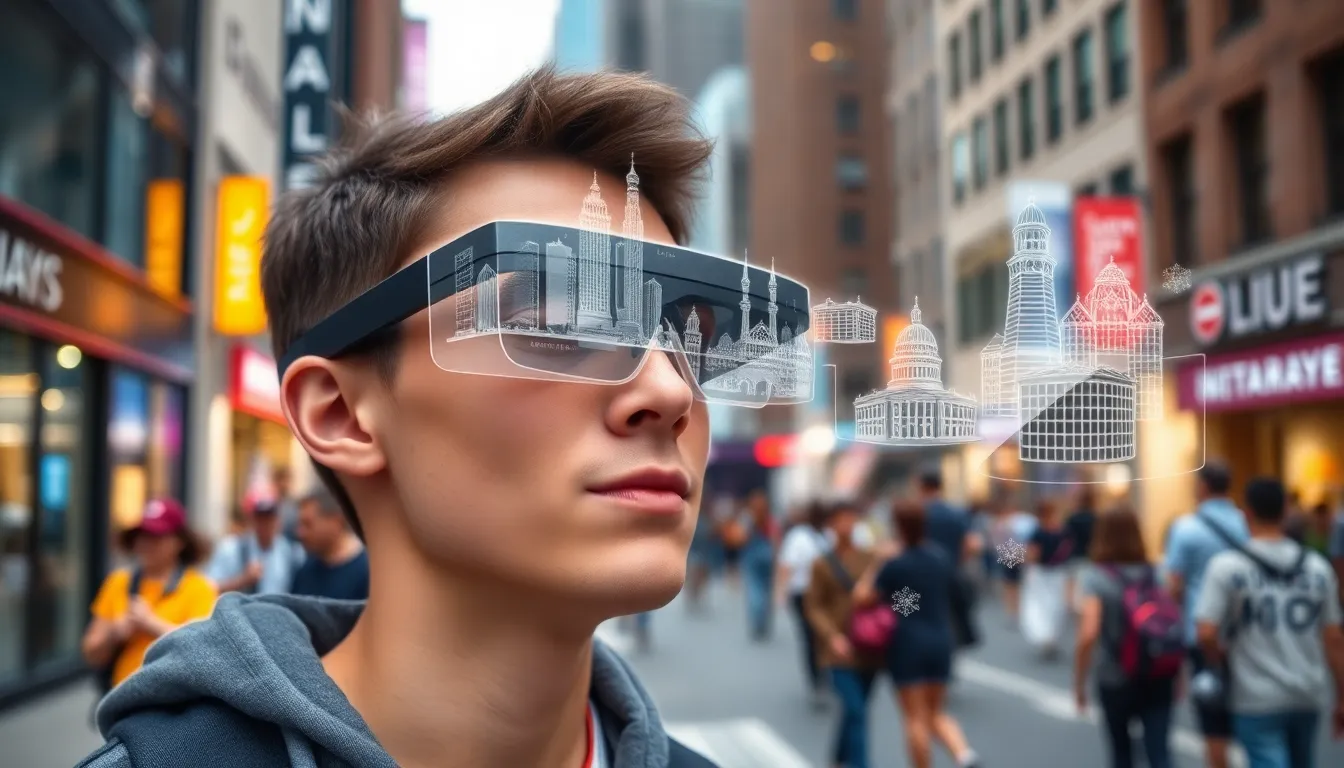Table of Contents
ToggleImagine walking down the street and suddenly seeing a giant pizza slice floating in front of you, guiding you to the nearest pizzeria. Welcome to the world of context-aware augmented reality (AR), where the digital and physical realms collide in the most delightful ways. This isn’t just a techie dream; it’s a game-changer that’s transforming how people interact with their surroundings.
Overview of Context-Aware AR
Context-aware augmented reality (AR) significantly enhances user experiences by merging digital information with real-world environments. This technology gathers data from surrounding conditions, allowing AR applications to respond dynamically. Users interact with their environments in real-time, increasing engagement and making digital content relevant to their current situation.
Context-aware AR relies on various inputs, such as location data, environmental conditions, and user preferences. By collecting and analyzing this information, AR systems can provide tailored experiences. For instance, if someone enters a new area, the AR application can display relevant information about nearby landmarks or establishments.
Applications of context-aware AR span countless fields. Retail environments use AR to offer personalized promotions based on user location within a store. Educational institutions implement AR to enrich learning experiences by overlaying additional information onto physical objects. In healthcare, AR assists medical professionals by visualizing data during procedures or patient consultations.
Privacy and security concerns often accompany the deployment of context-aware AR systems. Data collection involves sensitive information, necessitating robust security measures. Users typically require transparency regarding how their data is used and stored, which emphasizes ethical considerations in technology development.
Advancements in machine learning and computer vision continue to propel context-aware AR. Enhanced algorithms improve how AR applications interpret user context, resulting in more precise and relevant interactions. Stakeholders in various industries recognize the potential of context-aware AR to reshape user experiences and streamline operations.
Key Technologies Behind Context-Aware AR

Context-aware augmented reality relies on several key technologies that enable its dynamic interactions. Detecting surroundings and user behaviors enhances the user experience significantly.
Sensor Integration
Sensors play a crucial role in gathering real-time environmental data. GPS helps track precise locations, while accelerometers monitor device movements. Depth sensors create spatial maps, providing vital information about nearby objects. Integrating these sensors allows applications to adapt to different contexts, such as lighting and weather conditions, improving overall functionality. By leveraging data from multiple sensors, context-aware AR systems can offer personalized and relevant experiences.
Computer Vision Techniques
Computer vision techniques are fundamental for interpreting visual data in context-aware AR. Algorithms analyze images and video feeds, identifying objects, faces, and locations. This understanding allows AR applications to superimpose digital content on physical objects accurately. Feature detection plays a pivotal role, enabling recognition of surfaces and structures in real-time. Object tracking ensures that digital overlays remain aligned with the physical world as users move. Advanced machine learning models enable continuous improvement in object recognition, enhancing user interactions with their environments.
Applications of Context-Aware AR
Context-aware AR has diverse applications that enhance daily experiences across various industries.
Retail and E-commerce
Retailers leverage context-aware AR to engage customers. Personalized advertisements display when shoppers approach certain products. Virtual try-ons enable customers to visualize clothing or accessories before purchasing. Multiple brands report higher conversion rates due to these immersive experiences. By integrating location data, retailers guide consumers to promotions based on their present location within the store. User preferences further tailor recommendations, leading to increased satisfaction and loyalty.
Education and Training
Context-aware AR enriches education and training environments. Students engage in interactive lessons through digital overlays that enhance traditional concepts. Imagery and simulations bring complex subjects like biology or mathematics to life. Teachers utilize real-time feedback to adapt lessons based on student understanding. Practical applications, such as in surgical training, offer learners a safe, controlled environment to practice skills. This technology fosters deeper learning, making abstract ideas tangible and accessible.
Healthcare
Healthcare professionals benefit from context-aware AR during procedures and diagnostics. Surgeons access critical patient information overlaid directly onto the surgical field. Systems guide them with step-by-step instructions, reducing the potential for errors. Emergency responders utilize AR in crisis situations to receive real-time data on patient vitals. Diagnostics become more precise, thanks to enhanced imaging that displays relevant information for accurate assessments. This technology improves patient outcomes and streamlines medical practices.
Challenges in Implementing Context-Aware AR
Context-aware AR faces several significant challenges. These hurdles can impact the successful deployment and user acceptance of this technology.
Privacy Concerns
Data privacy issues top the list of challenges. Users express strong concerns about how their personal information is collected and used. Context-aware AR systems often rely on sensitive data, such as location and preferences, raising ethical questions. Regulations like the General Data Protection Regulation (GDPR) necessitate transparency in data handling practices. Companies must clearly inform users about data collection purposes and methods. Effective consent mechanisms are essential to build trust and enhance user adoption.
Technical Limitations
Technical constraints also hinder advancement. Many AR applications require sophisticated hardware for accurate data processing. Limited battery life of devices restricts prolonged usage, affecting user experience. Environmental factors, such as lighting and weather, can interfere with sensor accuracy, leading to unreliable performance. Developing robust algorithms for real-time data analysis poses additional challenges. These technical limitations require ongoing research and innovation to enhance the practicality and user-friendliness of context-aware AR solutions.
Future Trends in Context-Aware AR
Emerging advancements in context-aware AR technology shape its future trajectory. Increased integration of artificial intelligence enhances user interactions by providing more personalized experiences. Significant improvements in sensor technology lead to better data collection, allowing for more accurate environmental interpretations.
Companies in various sectors adopt context-aware AR solutions. Retailers leverage this technology to create immersive shopping experiences, allowing customers to visualize products in their homes before purchasing. In education, AR tools continue to evolve, facilitating interactive learning environments that engage students effectively.
Healthcare applications expand as well, with AR assisting in complex surgeries by overlaying critical information directly onto patients. This integration boosts precision and aids in training medical professionals, ultimately improving patient care.
Privacy and security concerns persist and shape the development of context-aware AR. Developers focus on implementing transparent data practices and obtaining user consent, addressing these issues head-on. Regulations like GDPR reinforce the need for ethical data handling and user trust.
Technical challenges must also be overcome to achieve widespread adoption of context-aware AR. Battery life limitations and hardware requirements often restrict usability in various environments. Ongoing research aims to develop lightweight algorithms that enhance performance while minimizing resource consumption.
The collaboration between developers and businesses will drive innovation. By prioritizing user privacy and technological advancements, context-aware AR can revolutionize how people engage with their surroundings across diverse industries.
Context-aware augmented reality is set to redefine interactions with the physical world. By blending digital information with real-life environments, it creates tailored user experiences that enhance daily activities. As various industries embrace this technology, the potential for personalized engagement grows exponentially.
While challenges like privacy concerns and technical limitations remain, ongoing advancements in AI and sensor technology promise to address these issues. The collaboration between developers and businesses is crucial for overcoming barriers and fostering innovation.
As context-aware AR continues to evolve, it stands to transform not only how individuals shop learn and receive healthcare but also how they connect with their surroundings in meaningful ways.







